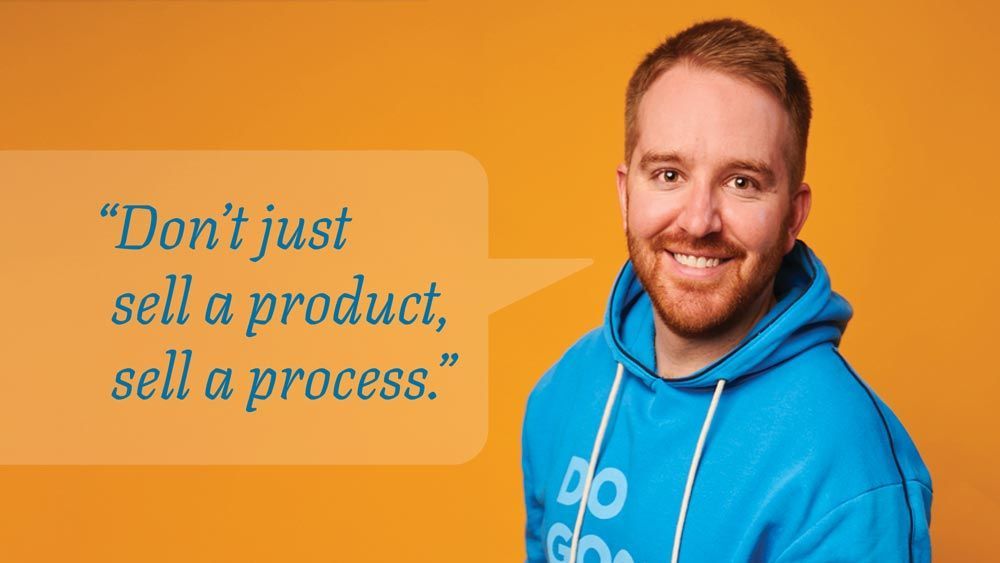Sean McDade has been helping companies optimize customer experiences for over twenty years. An angel investor in the Philadelphia region, he is also the founder, CEO, and visionary of PeopleMetrics, a leading provider of experience management software and advisory services. In addition to working with several leading pharmaceutical and biotechnology companies, he is the author of two books.
The Connection Between Brand & Customer Experience
Is your brand and customer experience related?
Explore these points of view to make your company, products, and services more customer-centric.
Section One of this article is by Sean McDade, Founder & CEO of PeopleMetrics.
Customer perception is everything today. Especially in today’s turbulent economy, being known as a distinct, reliable, high-quality business can give you the edge you need to drive results. Who wouldn’t want to be known as a business like that? This is why so many companies focus heavily on concepts like branding and customer experience (CX).
Brand and customer experience are sometimes thought about interchangeably. They are not interchangeable concepts, but they are closely interrelated.
Brand and customer experience impact each other in sometimes complex ways, and their connection has evolved a lot over the years. We believe it’s more important than ever for all businesses to understand these concepts so that they can navigate the shifting landscape with confidence.
In this guide, we’ll review brand, customer experience, and how they relate to and impact one another. Let’s dive in.
What is brand?
Traditionally, a company's brand was all about ownership of its product and literal insignias and logos. A brand was the set of symbols used to represent ownership and authority relating to a specific product.
Today, brand extends beyond physical signifiers alone and is somewhat abstract. It denotes the impression a company makes on its customers and the unique tint of satisfaction, aspiration, or other feelings that its products or services invoke (or seek to invoke). In other words, a brand is the promise a company makes to its customers and potential customers.
A company can also inspire different feelings in different audiences, which could be considered part of its overarching brand identity. For example, Disney (and its logo and properties) might mean magic to kids, reliability to parents looking to entertain their children, and nostalgia for many adults who grew up with the Disney brand. Taken together, the brand seeks to invoke happiness and warmth.
Notably, brands can exist and be encountered without a tangible interaction. People are already aware of the Disney brand even if they haven’t gone on vacation to Disneyland or seen the company’s most recent film.
What is customer experience (CX)?
If brand is the promise your company makes to customers, customer experience is how you keep that promise. If the experience you offer fails to deliver on the brand’s promise, customer experience also provides you with the structure and process for following up to resolve the issue and restore the promise.
Customer experience is all about interactions. It’s built on the idea that every interaction between you and your customers helps to shape their overall impressions and emotional connections to your business. This connection is what drives customer retention and business growth over time.
Since customer experience is impacted by every customer touchpoint, businesses seek to control and improve the impressions they’re making through proactive customer experience management and experience design. Boiled down to its essentials, this process involves a few keys steps:
- Creating an intentional experience, which usually starts by identifying a point in the customer journey that you want to study or improve.
- Collecting feedback from customers about the experience in real-time or right after they move through that point in their journey.
- Making strategic improvements to how your business facilitates or offers that experience based on the new customer feedback.
- Keeping it all running by continuing to collect customer insights and making changes in an iterative feedback loop.
An intentional customer experience strategy gives businesses the infrastructure needed to make data-driven process changes that will benefit customer outcomes. In other words, customer experience helps businesses be truly customer-centric.
How do brand and customer experience relate today?
We often think about branding as something that comes first in the customer journey: a recognizable image that precedes directly engaging with the company itself. The brand is the first impression fostered by your marketing, and it falls on the actual experience to continually live up to that impression—back to the promise/promise-keeper analogy. This is still true in many cases, particularly when you’re seeking to retain existing customers.
But today, the relationship between these concepts can be more complex. Unless you’re already a very recognizable brand, it works differently when you’re engaging with new customers for the first time. New customers will often experience your business before they have a direct or carefully curated impression of your brand.
So why does the initial experience of your company so often come before a full brand perception? Diverse forms of online marketing and advertising have become the first steps in many B2C and B2B relationships today. This means there are tons of ways customers can end up experiencing your business for the first time. In many cases, customers might even be looking up your reviews long before getting in touch with you directly.
These entry points are harder to study and manage than in the past when brand impression and the first steps of customer journeys could be tightly controlled and managed from the get-go. Today, these initial impressions are often quite brief or not in the form of traditional brand-based advertising. The lasting impression you make once customers are face-to-face with your business, like visiting your website or giving you a call after seeing you mentioned on social media, will be largely shaped by interactions.
Does your website look good once potential customers click through to it? Is it easy to find the information they’re looking for? What’s the experience like if a potential customer calls or emails to ask for more information?
The quality of these sorts of interactions plays a decisive role in the formation of initial brand perception. customer experience management gives you the framework to keep your promises and shape these interactions in an organic but controllable way.
How do brand and customer experience impact each other?
To further illustrate the modern relationship between brand and customer experience, let’s look at a few different example scenarios:
- Example 1: A new customer experiences an unknown brand that offers stellar customer experience. The quality, ease, and/or effectiveness of these initial interactions will begin shaping the customer’s impression of the brand in a positive direction, and the customer will be more likely to enjoy the experience and return over time.
- Example 2: A new customer experiences a recognized brand that offers poor customer experience, perhaps through a bad customer service interaction. The brand perception will suffer because the experience didn’t live up to the expectation, and the customer, if retained at all, will remember the poor interaction in the future.
- Example 3: A customer returns to a business that offers strong customer experience and attentive service. Compounded over the business’s entire customer base, its brand perception will improve. And if the business intentionally measures net promoter scores and asks for referrals, it’ll see improved business outcomes across the board.
- Example 4: A customer returns to a business and has a poor experience at some point in their journey. Hassles, less-than-satisfying service, and technical confusion can all compound across the customer base to negatively impact the brand’s perception over time. Even with the best marketing tactics, a bad reputation among existing customers can cause irreparable harm and will seep out to impact its perception among non-customers, too.
These are very simplified examples, but they get to the core of the relationships between brand and customer experience. Great customer experience fuels a strong brand that customers enjoy engaging with. Reinforcing and growing positive brand perception then becomes a continuous process as you keep acquiring, engaging, and retaining customers.
A robust customer experience management process should give you the tools, infrastructure, and language you need to start optimizing every interaction with your customers over time and deliver on the promises you make to your customers.
Use customer experience to learn more about your customers’ perceptions of your business and how their experiences are shaping their impression of your brand. Discover what they most value about your experiences, products, and/or services. Then, extrapolate these findings to your marketing so that you can start proactively shaping your own brand based on what you already know pleases customers about your business. Use your customer experience infrastructure to test branding changes, or form customer advisory panels if you want finer control.
Customer experience tools and know-how plus a little creativity can open up a ton of ways to start driving improvements for your business and its brand.
Key Takeaways
Customer experience creates and shapes brand perception in fundamental ways for many businesses today, especially smaller businesses and those that rely heavily on the internet to reach customers.
Customer experience can also give you the framework you need to take control of your brand perception so that it can become a more intentional strategic asset, rather than just the ad hoc result of the interactions and experiences you offer customers. By actively working to study and improve customer experiences, you’ll build a stellar reputation and a brand that attracts attention, repeat business, and new customers like a magnet.
Section Two of this article is by Brian Sooy, Brand Architect and founder of Aespire.
Is a brand a promise?
There is an inherent promise in what a company says to a customer (We promise X for Y), but a brand is more than a promise.
Marty Neumeier, the author of The Brand Gap, states that a brand is a customer’s gut feeling about a product, service, experience, or company.
Researchers and academics hold a traditional view that brands are the constellation of shared associations surrounding a company and its offerings.
“Brand as promise” means we can approach customer experience as a promissory experience. When consumers choose to do business with your company, they anticipate what to expect because your branding creates a perception of what they should expect.
The brand is the customer’s experience and the story they share about it with their friends and family.
Business leaders have been led to believe that companies have values, but they don’t. People have values; companies should have guiding principles that align people with different values around principles that form a shared culture.
Likewise, Companies and brands don’t make promises, people do.
A brand is not what you (as the brand owner) say; a brand is what your customers say. A brand is a frame that should make a consumer’s story and experience more meaningful.
A brand is a story people tell themselves about what your product or service means for them. The story (about your brand) gets formed every time people experience and interact with your brand.
— Brian Sooy
Recommended Reading:
- Brand as Promise, Vikram R. Bhargava & Suneal Bedi
- The Brand Gap, Marty Neumeier
- Three Ways to Transform Customer Experience
- BP: The Perils Of Prematurely Making A Brand Promise
Do you have a hard time explaining what your company does or why your brand matters to people?
If you struggle to grow your business, you’re not alone. Aespire can help you create a clear message and brand that helps you grow your business. Contact us today for a consultation with a StoryBrand Certified Marketing Guide.
Get a Free Comprehensive Marketing Assessment
Stop hoping your marketing will sort itself out.
- Complete this free assessment in 15 minutes.
- Review your custom report (and schedule a 30-minute review) to diagnose what’s happening.
- Create an action plan to get your marketing back on track.








